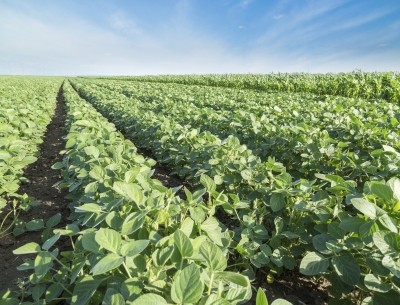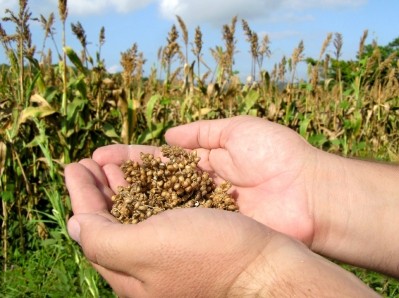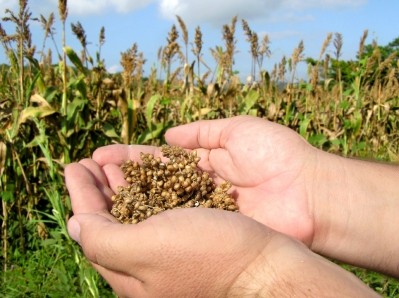Record US soybean planting expected

The US Department of Agriculture (USDA) published its prospective planting report on Friday (31 March).
The total acres planted moved from about 319m last year to 316m for 2017, said the agency. The amount will be below what was planted in 2015, it forecast.
Although some fluctuation in the planting of feed grains was expected, the decrease was higher than anticipated, said Christopher Hurt, professor of agricultural economics with Purdue University. Corn acreage dropped by about a million acres more than anticipated, and intended soybean plantings jumped higher than predicted.
There has yet to be a point in the US where the acres planted in soybeans are larger than those planted in corn, but this year’s intended plantings bring crop acerage closer than ever, with about 90m acres of corn and 89.5m acres of soybeans, he said. “What we have is continued growth of demand for soybeans – corn demand or usage is slower,” he added.
He told FeedNavigator. “Along with corn, we also had reduction in the other feed grains, sorghum, oats and barley, and those were all sizable reductions. The shift is from feed grains and wheat to oilseeds and cotton.”
The change could mean higher prices for corn or sorghum but lower ones for protein meals, he said.
"Feed industry [members] and users can feel a little more assured that feed supplies will be abundant."
Weather is the big force that could really change the supplies at this point, he said. “Acreage is the foundation, but weather can cause big differences in yields.”
Corn
Corn planted area for all purposes in 2017 is estimated at 90m acres, down 4% or 4m acres from last year. However, the predicted crop planted area would be higher than the equivalent in 2015.
The overall drop in expected corn planting is anticipated to offer a price boost for the feed grain, said Hurt. The prediction is that corn could be $0.30-$0.35 a bushel higher than the 2016 crop.
The states that saw the largest reduction in the percentage of acres to be planted include Alabama, Arizona, Arkansas and Mississippi, said the USDA. However, Nevada, Oregon and Utah had the largest percentage increase in acres planted.
Soybean specifics
The forecast for soybeans is for acreage to increase to a record high 89.5m acres, a 7% increase from last year, said the USDA. Intentions for planted acres grew or stayed the same in 27 of the 31 states accounting for the majority of the soybean crop.
The increase in acres planted in soybeans is anticipated to bring down the price of soybean meal, which may be a benefit for feed producers, said Hurt. The expectation is that the price per ton for soybean meal could reach or drop below $300.
“The consequence of getting acreage down and getting price up is that soybeans will suffer in terms of prices,” he said.
However, the acreage change and the potential for lower prices likely will not induce many producers to switch from growing soybeans to another crop this year, he said.
“Even with the change in prices after the report, we still show that soybeans are favored by $30-50 an acre over corn,” he said. “We’ve seen a really strong premium of expected return on soybeans while this moves in the direction of reducing the incentive but it doesn’t [end it].”
The USDA said the states that are likely to see some of the larger increases in the percentage of acres to be planted include Arkansas, Kansas, Louisiana, Michigan, Mississippi, Nebraska, North Dakota Oklahoma, and Wisconsin.
Wheat, sorghum
Planting intentions for wheat are a record low, said the USDA. The 46.1m acres estimated to be planted in wheat for 2017 would be down 8% from 2016 -the smallest area planted since at least 1919.
The estimated area planted with winter wheat is 342.7m acres, a drop of 9% from 2016 – the second smallest acreage on record, said the department.
Wheat could see price rebounds of about $0.25 a bushel, said Hurt. With normal yields in the production year, the acreage reduction will help reduce carryout.
The USDA predicted the area to be planted in oats for the 2017 crop year is down about 5% to 2.7m acres. It would be the second smallest amount planted, if growers remain consistent with the early intentions.
Sorghum growers have said they intend to plant about 5.76m acres of sorghum, a drop of 14% from the previous year, said the department. “If realized, acres planted to sorghum in Arkansas, Georgia, Mississippi, and Missouri will be the lowest on record,” it added.
The amount is provoking some concern from the National Sorghum Producers group. If planted acres remain low, the production may not meet established demand for the feed grain, it said.
CEO of the sorghum association, Tim Lust, said:
“As we know from past years, this report is a survey of intentions weeks before the actual report. With recent weather events across four states, we feel confident there will be additional sorghum acres likely behind failed wheat and other crops. Relatively, demand for sorghum continues to rise, and expected ending stocks-to-use ratios are now down to 7.92%.
"Current sorghum prices, like corn and wheat prices, are a reflection of our current economy and the situation farmers are facing with local basis. We also recognize our challenge in supplying growing domestic and export demand that continues to aggressively seek sorghum at-cost or above the corn price in more locations across the sorghum belt, particularly at export terminals. This is encouraging for our industry, and as our mission remains focused on maximizing sorghum producer profitability, we encourage farmers to evaluate the entire market and policy landscape as they make planting decisions this spring.”













